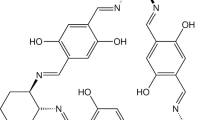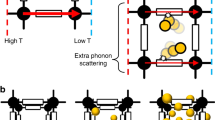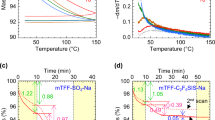Abstract
Three water adsorption–desorption mechanisms are common in inorganic materials: chemisorption, which can lead to the modification of the first coordination sphere; simple adsorption, which is reversible; and condensation, which is irreversible. Regardless of the sorption mechanism, all known materials exhibit an isotherm in which the quantity of water adsorbed increases with an increase in relative humidity. Here, we show that carbon-based rods can adsorb water at low humidity and spontaneously expel about half of the adsorbed water when the relative humidity exceeds a 50–80% threshold. The water expulsion is reversible, and is attributed to the interfacial forces between the confined rod surfaces. At wide rod spacings, a monolayer of water can form on the surface of the carbon-based rods, which subsequently leads to condensation in the confined space between adjacent rods. As the relative humidity increases, adjacent rods (confining surfaces) in the bundles are drawn closer together via capillary forces. At high relative humidity, and once the size of the confining surfaces has decreased to a critical length, a surface-induced evaporation phenomenon known as solvent cavitation occurs and water that had condensed inside the confined area is released as a vapour.
This is a preview of subscription content, access via your institution
Access options
Subscribe to this journal
Receive 12 print issues and online access
$259.00 per year
only $21.58 per issue
Buy this article
- Purchase on Springer Link
- Instant access to full article PDF
Prices may be subject to local taxes which are calculated during checkout




Similar content being viewed by others
References
Nair, R. R., Wu, H. A., Jayaram, P. N., Grigorieva, I. V. & Geim, A. K. Unimpeded permeation of water through helium-leak-tight graphene-based membranes. Science 335, 442–444 (2012).
Furmaniak, S., Gauden, P. A., Terzyk, A. P. & Rychficki, G. Water adsorption on carbons - Critical review of the most popular analytical approaches. Adv. Colloid Interfac. 137, 82–143 (2008).
Meng, L. Y. & Park, S. J. Superhydrophobic carbon-based materials: a review of synthesis, structure, and applications. Carbon Lett. 15, 89–104 (2014).
Canivet, J., Fateeva, A., Guo, Y. M., Coasne, B. & Farrusseng, D. Water adsorption in MOFs: fundamentals and applications. Chem. Soc. Rev. 43, 5594–5617 (2014).
Li, X., Li, H. L., Huo, S. Q. & Li, Z. Dynamics and isotherms of water vapor sorption on mesoporous silica gels modified by different salts. Kinet. Catal. 51, 754–761 (2010).
Dominguez, A., Holthaus, S. G., Koppen, S., Frauenheim, T. & da Rosa, A. L. The role of water co-adsorption on the modification of ZnO nanowires using acetic acid. Phys. Chem. Chem. Phys. 16, 8509–8514 (2014).
Polarz, S. Shape matters: anisotropy of the morphology of inorganic colloidal particles - synthesis and function. Adv. Funct. Mater. 21, 3214–3230 (2011).
Nath, M., Choudhury, A., Kundu, A. & Rao, C. N. R. Synthesis and characterization of magnetic iron sulfide nanowires. Adv. Mater. 15, 2098–2101 (2003).
Anugwom, I. et al. Switchable ionic liquids (SILs) based on glycerol and acid gases. RSC Adv. 1, 452–457 (2011).
Hu, X. D. et al. Electrically switchable capillarity of ionic liquids. J. Adhes. Sci. Technol. 26, 2069–2078 (2012).
Jessop, P. G., Heldebrant, D. J., Li, X. W., Eckert, C. A. & Liotta, C. L. Green chemistry: reversible nonpolar-to-polar solvent. Nature 436, 1102–1102 (2005).
Jessop, P. G., Mercer, S. M. & Heldebrant, D. J. CO2-triggered switchable solvents, surfactants, and other materials. Energ Environ Sci 5, 7240–7253 (2012).
Nixon, E. C. et al. Reversible ionic liquids as switchable surfactants for the synthesis of gold nanoparticles. Abstr. Pap. Am. Chem. S 242 ( 2011).
Heldebrant, D. J., Yonker, C. R., Jessop, P. G. & Phan, L. Reversible uptake of COS, CS2, and SO2: ionic liquids with O-alkylxanthate, O-alkylthiocarbonyl, and O-alkylsulfite anions. Chem. Eur. J. 15, 7619–7627 (2009).
Wei, L., Yi, X., Kun, Z. & Fei, Z. The large-scale synthesis and characterization of carbon nanotubes filled with long continuous inorganic nanowires in supercritical CS2 . Nanotechnology 17, 5702–5706 (2006).
McCallum, C. L., Bandosz, T. J., McGrother, S. C., Muller, E. A. & Gubbins, K. E. A molecular model for adsorption of water on activated carbon: comparison of simulation and experiment. Langmuir 15, 533–544 (1999).
Omar, A. M. E. & Roos, Y. H. Water sorption and time-dependent crystallization behaviour of freeze-dried lactose-salt mixtures. LWT Food Sci. Technol. 40, 520–528 (2007).
Boursiquot, S., Mullet, M., Abdelmoula, M., Génin, J. M. & Ehrhardt, J. J. The dry oxidation of tetragonal FeS1−x mackinawite. Phys. Chem. Min. 28, 600–611 (2001).
Li, J.-S. et al. Heteroatoms ternary-doped porous carbons derived from MOFs as metal-free electrocatalysts for oxygen reduction reaction. Sci. Rep. 4, 5130 (2014).
Casanovas, J., Ricart, J. M., Rubio, J., Illas, F. & Jiménez-Mateos, J. M. Origin of the large N 1s binding energy in X-ray photoelectron spectra of calcined carbonaceous materials. J. Am. Chem. Soc. 118, 8071–8076 (1996).
Jeon, J.-W. et al. In situ one-step synthesis of hierarchical nitrogen-doped porous carbon for high-performance supercapacitors. ACS Appl. Mater. Interfac. 6, 7214–7222 (2014).
David, B. et al. Powders with superparamagnetic Fe3C particles studied with Mössbauer spectrometry. J. Phys. Conf. Ser. 217, 012097 (2010).
David, B. et al. Preparation of iron/graphite core-shell structured nanoparticles. J. Alloys Compd. 378, 112–116 (2004).
Murad, E. & Cashion, J. Mössbauer Spectroscopy of Environmental Materials and Their Industrial Utilization (Kluwer Academic, 2004).
Picaud, S., Collignon, B., Hoang, P. N. M. & Rayez, J. C. Adsorption of water molecules on partially oxidized graphite surfaces: a molecular dynamics study of the competition between OH and COOH sites. Phys. Chem. Chem. Phys. 10, 6998–7009 (2008).
Yang, Y., Meng, S. & Wang, E. G. Water adsorption on a NaCl (001) surface: a density functional theory study. Phys. Rev. B 74, 245409 (2006).
Chen, Y. W. & Cheng, H. P. Structure and stability of thin water films on quartz surfaces. Appl. Phys. Lett. 97, 161909 (2010).
Sundararajan, M. X-ray Scattering Study of Capillary Condensation in Mesoporous Silica MSc thesis, Ohio Univ. (2013).
Morishige, K. & Kittaka, S. Kinetics of capillary condensation of water in mesoporous carbon: nucleation and meniscus growth. J. Phys. Chem. C 119, 18287–18292 (2015).
Ashbaugh, H. S. Solvent cavitation under solvophobic confinement. J. Chem. Phys. 139, 064702 (2013).
Sharma, S. & Debenedetti, P. G. Evaporation rate of water in hydrophobic confinement. Proc. Natl Acad. Sci. USA 109, 4365–4370 (2012).
Lum, K., Chandler, D. & Weeks, J. D. Hydrophobicity at small and large length scales. J. Phys. Chem. B 103, 4570–4577 (1999).
Cerdeirina, C. A., Debenedetti, P. G., Rossky, P. J. & Giovambattista, N. Evaporation length scales of confined water and some common organic liquids. J. Phys. Chem. Lett. 2, 1000–1003 (2011).
Hummer, G., Rasaiah, J. C. & Noworyta, J. P. Water conduction through the hydrophobic channel of a carbon nanotube. Nature 414, 188–190 (2001).
Xu, L. M. & Molinero, V. Liquid-vapor oscillations of water nanoconfined between hydrophobic disks: thermodynamics and kinetics. J. Phys. Chem. B 114, 7320–7328 (2010).
Leung, K., Luzar, A. & Bratko, D. Dynamics of capillary drying in water. Phys. Rev. Lett. 90, 065502 (2003).
Pangali, C., Rao, M. & Berne, B. J. Monte-carlo simulation of the hydrophobic interaction. J. Chem. Phys. 71, 2975–2981 (1979).
Luzar, A. Activation barrier scaling for the spontaneous evaporation of confined water. J. Phys. Chem. B 108, 19859–19866 (2004).
Wallqvist, A. & Berne, B. J. Computer-simulation of hydrophobic hydration forces on stacked plates at short-range. J. Phys. Chem. 99, 2893–2899 (1995).
Rabinovich, Y. I., Derjaguin, B. V. & Churaev, N. V. Direct measurements of long-range surface forces in gas and liquid-media. Adv. Colloid Interfac. 16, 63–78 (1982).
Israelachvili, J. & Pashley, R. The hydrophobic interaction is long-range, decaying exponentially with distance. Nature 300, 341–342 (1982).
Morrone, J. A., Li, J. & Berne, B. J. Interplay between hydrodynamics and the free energy surface in the assembly of nanoscale hydrophobes. J. Phys. Chem. B 116, 378–389 (2012).
Sharma, S. & Debenedetti, P. G. Free energy barriers to evaporation of water in hydrophobic confinement. J. Phys. Chem. B 116, 13282–13289 (2012).
Acknowledgements
The authors thank the Pacific Northwest National Laboratory's (PNNL) Materials Synthesis and Simulation Across Scales (MS3) Initiative Laboratory Directed Research and Development (LDRD) programme for the support. XPS, Mössbauer spectroscopy, SEM, TEM and environmental SEM and TEM characterization was performed at EMSL, a national scientific user facility sponsored by the Department of Energy's Office of Biological and Environmental Research, located at PNNL. PNNL is a multi-programme national laboratory operated for the US Department of Energy by Battelle under Contract DE-AC05-76RL01830. S.K.N. and D.J.H. thank J. S. Loring for infrared analysis and M. Perkins for 3D drawings.
Author information
Authors and Affiliations
Contributions
S.K.N. and D.J.H. conceived the idea. D.B.L. synthesized all materials. S.K.N. and J.L. performed water sorption analysis. R.K.K. performed Mossbauer spectroscopy. M.N. and M.H.E. performed XPS measurements. M.J.O. performed TEM and SEM measurments and L.M.G. performed environmental TEM and SEM imaging. H.T.S. performed powder X-ray crystallography and D.W.G. performed estimation of surface density for water adsorption on carbon. S.K.N. and D.J.H. wrote the manuscript with the help of all co-authors.
Corresponding authors
Ethics declarations
Competing interests
The authors declare no competing financial interests.
Supplementary information
Supplementary information
Supplementary information (PDF 2122 kb)
Supplementary Movie 1
Supplementary Movie 1 (GIF 4795 kb)
Supplementary Movie 2
Supplementary Movie 2 (MOV 31575 kb)
Rights and permissions
About this article
Cite this article
Nune, S., Lao, D., Heldebrant, D. et al. Anomalous water expulsion from carbon-based rods at high humidity. Nature Nanotech 11, 791–797 (2016). https://doi.org/10.1038/nnano.2016.91
Received:
Accepted:
Published:
Issue Date:
DOI: https://doi.org/10.1038/nnano.2016.91



